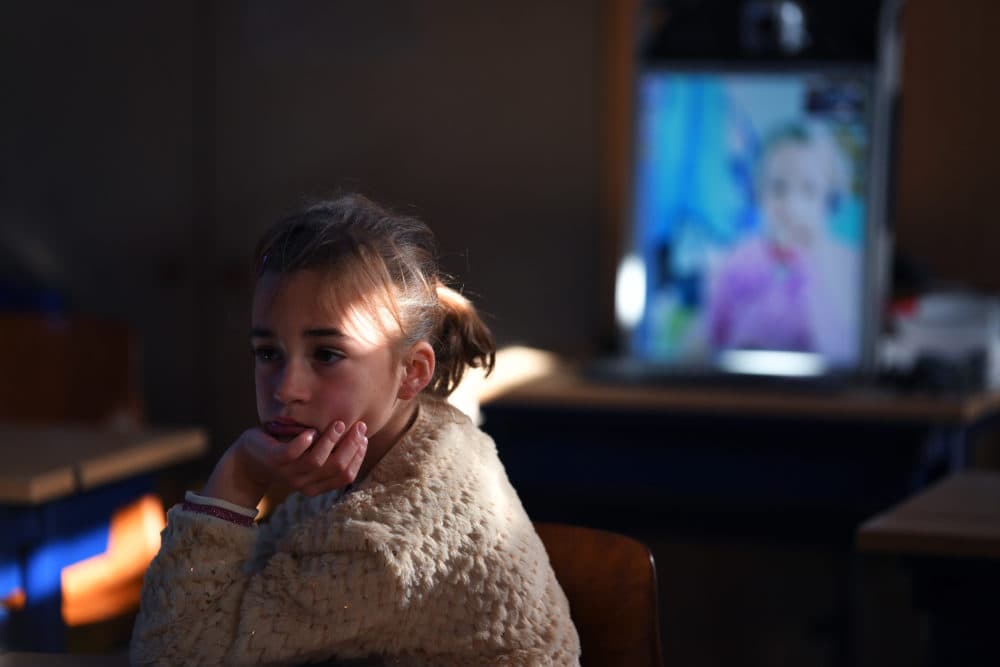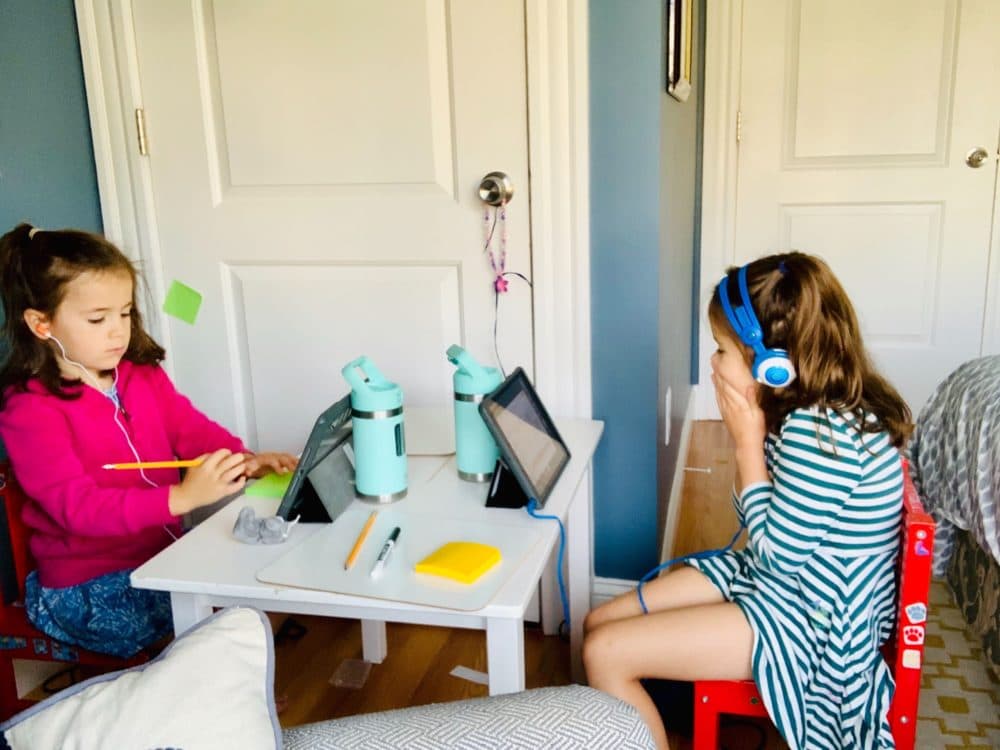Advertisement
‘Losing The Thread Of What We’ve Lost’: A Postcard From The Pandemic

Two hours into the first day of remote first grade, one of my 6-year-old twins asked: “Mom, do we have to do this again tomorrow?” Her sister, across the table, had her beloved blue blanket tucked up under her chin. She fidgeted with a yellow pad of Post-It notes, distracting herself from whatever she was supposed to be doing on her school-issued iPad.
So far, coronavirus first grade is basically OK, and also terrible. Kind of like the last seven months of pandemic life have been.
In fairness, their teacher is doing an excellent job. She’s energetic and warm and so well prepared. (Clearly, elementary school teachers should be paid $1 million.) It’s just that this new normal we’re all working so hard to adjust to — the normal where our kids go to school at home, and we work from desks shoved into corners of our bedrooms, and the president attaboys white supremacists, and the West Coast is on fire, and RBG is dead, and we only see friends outdoors and everybody checks the daily COVID-19 positivity rate like the weather — is very far from normal.
In the past seven months, we’ve all been tasked with becoming amateur epidemiologists, pollsters, educators and doctors. I’ve grudgingly learned about R0 and dispersion, common core math and the idiosyncrasies of the Electoral College. Sometimes when I think about the “before times” I can’t believe it. Did I really host a kid birthday party last winter at an indoor venue with giant inflatables? Did I actually spend an afternoon with a friend at a bathhouse with a cold plunge pool and a steam room? Yes, yes I did.
It’s disorienting to be grasping for clarity that is so stubbornly elusive.
Now I talk casually about my family’s “risk budget.” Most recently, I’ve been scrutinizing the decision to transition our girls to in-person instruction. I’m trying to parse community transmission rates with the desire, frankly, to get my kids out of the house. But such is 2020 that this one thing — whether or not to send my kids to school two or three mornings a week — is a question with important consequences and no right answer. It’s disorienting to be grasping for clarity that is so stubbornly elusive. It’s all I can do to remind myself of the sage advice offered up by epidemiologist Dr. Michael Osterholm: it’s a COVID year in education, a mulligan.
Early on in the pandemic, I listened over and over to an interview Cheryl Strayed did with her mentor, the author George Saunders. Saunders teaches creative writing at Syracuse University, and as the coronavirus took hold, he wrote a letter to his students (it’s since been published in the New Yorker). He wanted to remind them of their role, as recorders of history:
Advertisement
“It’s good for the world for a writer to bear witness, and it’s good for the writer, too. Especially if she can bear witness with love and humor and, despite it all, some fondness for the world, just as it is manifesting, warts and all.”
I took solace in those words. As a writer, and a person who works with writers, they reminded me of my purpose. But as the pandemic wore on, and 10,000 deaths became 50,000 and now 200,000 — with no end in sight — I stopped being able to do what used to come naturally, to observe and to feel. I felt so distracted by anger and sadness that it was hard to pay attention, and for months, I wasn’t sure what to think or feel about anything. A sort of numbness set in.

I don’t think this is uncommon. We know from research that trauma is an experience of the body, and that it manifests itself in different ways. Think about the people you know. Some of us go quiet, receding so far into ourselves we are beyond reach; others get sad, or angry, or manic in our attempt to find answers. Lots of people I know have stopped paying attention to the news, because it’s all just too much.
The question we once asked each other to be polite — “How are you?” — is oddly intimate now. “Oh, I’m fine,” we answer. It goes without saying that we’re exasperated and exhausted and furious, but we’re still here. We’re alive. I’m worried about what’s to come over the next few months, when it gets dark and cold.
In many ways, though, things are better now than they were in March. (Of course, that’s a testament to my enormous privilege; it’s contemptible that I complain at all.) I’m not nearly as anxious as I was then, or as scared. Seeing friends, even from a distance — even when you can’t hug them close — is a massive improvement over lockdown. I can do a Target run without fretting that I might catch COVID-19. I also now have some regular, reliable childcare.
... it’s hard to stay vulnerable when the world is so piercing. And when it would be easier to shut it out.
But this very human ability of ours to adapt, to find the best in things, to acclimatize to death and pain, also seems to me like our kryptonite. As we take on water, and stay afloat — because we have no choice — we’re at risk of losing the thread of what we’ve lost. Or how hard all of this is.
Saunders cautions his students to keep their hearts open, and I’m trying to once more. But it’s hard to stay vulnerable when the world is so piercing. And when it would be easier to shut it out.
My girls have glow-in-the-dark stars on the ceiling in their room. Over one kid’s bed, we tacked the Big Dipper; and over the other’s, a comet — or maybe it’s a shooting star. Either way, I gaze up at it when it’s my turn to tuck them in.
Their world, our world, has become unimaginably small. As fearful as I am of leaving my cocoon, I long for life beyond my bubble; I’d love to know some things for certain and I'm desperate for spontaneity. A constant contradiction.
But when I am lying on their floor, after I’ve read books and tickled backs, it’s easier, for a moment, to just be.
This segment aired on October 13, 2020.
